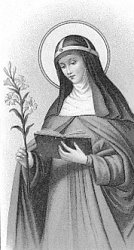Saint of the Day: St. Catherine of Sweden, Patron Saint Against Abortion
 St. Catherine of Sweden is the patron saint against abortion and miscarriages. She was born in 1331, the fourth of eight children, to Saint Bridget of Sweden and Ulf Gudmarsson.
St. Catherine of Sweden is the patron saint against abortion and miscarriages. She was born in 1331, the fourth of eight children, to Saint Bridget of Sweden and Ulf Gudmarsson.At the age of seven, Catherine was sent to Risberg Convent to be educated. She desired to remain in the convent to pursue a religious vocation, but she was promised in marriage to the virtuous and pious German noble Eggard Lydersson von Kürnen, a lifelong invalid. At age 13, the two were united in the sacrament of matrimony. Although Catherine was very beautiful, she and Eggard took a mutual vow of perpetual chastity. They devoted themselves to a life of Christian perfection and active charity.
In 1348, Catherine's father died. With Eggard’s permission, Catherine joined her mother on various pilgrimages. During these pilgrimages, they visited the tombs of the martyrs the churches, and together practiced works of piety, caring for the poor and the sick. In 1349, Catherine traveled with her mother to Rome for the Jubilee; it was at this time that Eggard died. Following his death, Catherine turned down numerous marriage proposals.
When her mother died in 1373, she returned to Sweden, taking the mortal remains of Saint Bridget with her for burial. Catherine entered a monastery at Vatzan, where she lived a very austere life. For the last twenty-five years of her life, Catherine participated in the Sacrament of Reconciliation daily to purify her soul. She died on March 24, 1381. At the time of her death, Catherine was the superior of the convent of Wadstena, founded by her mother; hence the name, Catherine Vastanensis, by which she is occasionally called. She was canonized in 1484 by Pope Innocent VIII.
St. Catherine wrote a devotional work entitled "Consolation of the Soul." In art, Saint Catherine is commonly depicted as an abbess with a female deer, which, according to legend, protected her from attacks on her chastity. She may also be shown (1) holding a lily; (2) dressing a poor man's wounds; or (3) as the Blessed Sacrament is brought to her after her death.




Comments
Post a Comment
Comments are moderated and are published at the blogger's discretion.